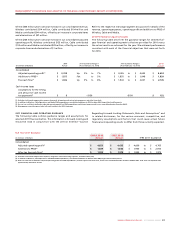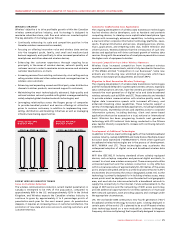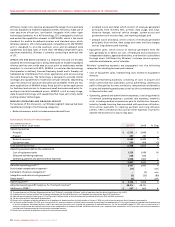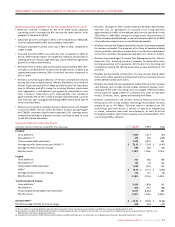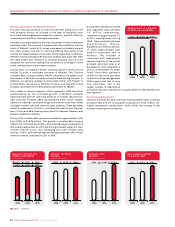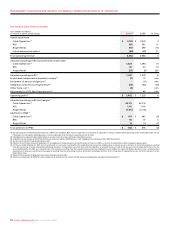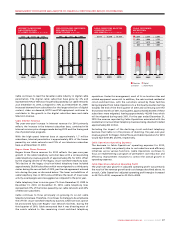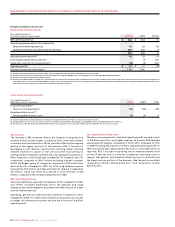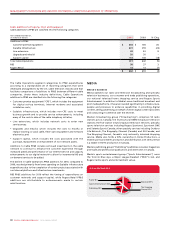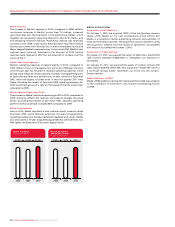Rogers 2010 Annual Report Download - page 29
Download and view the complete annual report
Please find page 29 of the 2010 Rogers annual report below. You can navigate through the pages in the report by either clicking on the pages listed below, or by using the keyword search tool below to find specific information within the annual report.
MANAGEMENT’S DISCUSSION AND ANALYSIS OF FINANCIAL CONDITION AND RESULTS OF OPERATIONS
ROGERS COMMUNICATIONS INC. 2010 ANNUAL REPORT 33
Increasing Availability of Online Access to Cable TV Content
Cable and content providers in the U.S. and Canada continue to create
platforms and portals which provide for online access to certain
television content via broadband Internet connections instead of
traditional cable television access. These platforms, including one
launched in late 2009 by Cable called Rogers On-Demand Online,
generally provide authentication features, which control and limit
access to content that is subscribed to at the user’s residence. The
launch and development of these online content platforms are in the
early stages and are subject to ongoing discussions between content
providers and cable companies with respect to how access to televised
and on-demand content is granted, controlled and monetized. It is
unclear whether such platforms will be complementary or competitive
to Cable’s business over time.
Facilities-Based Telephony Services Competitors
Competition has remained intense for a number of years in the long-
distance telephony service markets with the average price per minute
continuing to decline year-over-year. Competition in the local telephone
market also continues to be intense between Cable, ILECs and various
VoIP providers.
CABLE OPERATING AND FINANCIAL RESULTS
For purposes of this discussion, revenue has been classified according to
the following categories:
• Cable,whichincludesrevenuederivedfrom:
• analogcableservice,consistingofbasiccableservicefeesplus
extended basic (or tier) service fees, and access fees for use of
channel capacity by third and related parties; and
• digitalcableservicerevenue,consistingofdigitalchannelservice
fees, including premium and specialty service subscription fees,
PPV service fees, VOD service fees, and revenue earned on the sale
and rental of digital cable set-top terminals;
• Internet,whichincludesmonthlyandadditionaluseservicerevenues
from residential and small business Internet access service and
modem sale and rental fees;
• RogersHomePhone,whichincludesrevenuesfromresidentialand
small business local telephony service, calling features such as voice
mail and call-waiting, and long-distance;
• RBS,which includes local andlong-distancerevenues, enhanced
voice and data services revenue from enterprise and government
customers, as well as the sale of these offerings on a wholesale basis
to other telecommunications carriers and within RCI; and
• Rogers Retail, which includes commissions and revenues earned
while acting as an agent to sell other Rogers’ services, such as
wireless, Internet, digital cable and cable telephony, as well as the
sale and rental of DVDs and video games.
Operating expenses are segregated into the following categories for
assessing business performance:
• Salesandmarketingexpenses,whichincludesalesandretention-
related advertising and customer communications as well as other
customer acquisition costs, such as sales support and commissions
as well as costs of operating, advertising and promoting the Rogers
Retail chain;
• Operating,generalandadministrativeexpenses,whichincludeall
other expenses incurred to operate the business on a day-to-day
basis and to service subscriber relationships, including:
• the monthly contracted payments for the acquisition of
programming paid directly to the programming suppliers,
copyright collectives and the Canadian Programming Production
Funds;
• Internet interconnectivity and usage charges and the cost of
operating Cable’s Internet service;
• inter-carrierpaymentsforinterconnecttothelocal access and
long-distance carriers related to cable and circuit-switched
telephony service;
• technicalserviceexpenses,whichincludethecostsofoperating
and maintaining cable networks as well as certain customer
service activities, such as installations and repair;
• customercareexpenses,whichincludethecostsassociatedwith
customer order-taking and billing inquiries;
• community television expenses, which consist of the costs to
operate a series of local community-based television stations per
regulatory requirements in Cable’s licenced systems;
• expenses related tothecorporate management oftheRogers
Retail stores; and
• othergeneralandadministrativeexpenses.
• CostofRogersRetailsales,whichiscomposedofstoremerchandise
and depreciation related to the acquisition of DVD and game rental
assets.
In the cable industry in Canada, the demand for services, particularly
Internet, digital television and cable telephony services, continues to
grow and the variable costs associated with this growth, such as the
cost of content, commissions for subscriber activations, as well as the
fixed costs of acquiring new subscribers, are material. As such,
fluctuations in the number of activations of new subscribers from
period-to-period result in fluctuations in sales, marketing, cost of sales
and field services expenses.


